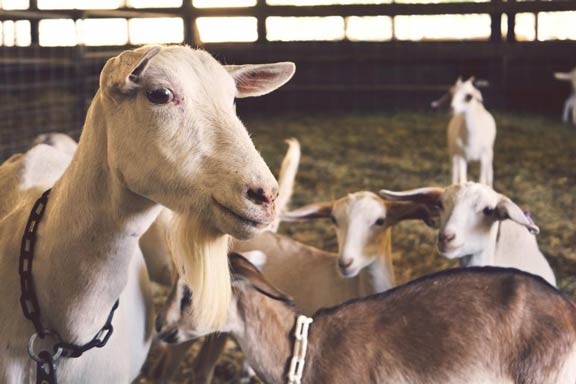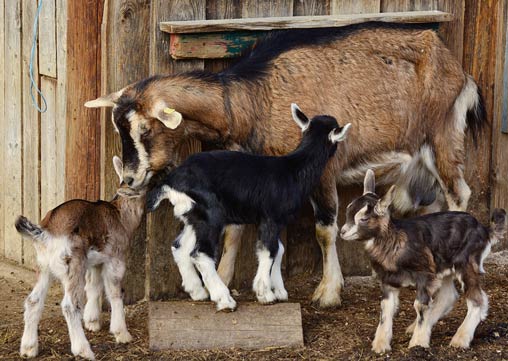People often opt for goats as the apt livestock choice for their small farms. But it is critical to understand how many goats you can raise per acre. According to animal husbandry experts, it is ideal to limit the number from 6 to 8 goats per acre to ensure a healthy, productive, and profitable livestock business.
Farm owners may use discretion to decide the exact number depending on various factors including the size of the breed, features of the forage land etc. Now let’s go ahead and dig deep into the factors that affect the number of goats we can have per acre.
How many goats per acre: the deciding factors
Goats deserve a certain space to roam and graze. But deciding the number of goats per acre might be a tricky question given a plenitude of factors to ponder – the breed & size of the goat, stage of life, region & terrain, climatic conditions, landscape, soil quality, pasture condition, plant varieties, rainfall, and other weather conditions.
Also, as they are social creatures, it is recommended to avoid isolation. A small group or at least a duo is ideal for their overall well-being in the long run. One may pick two goats from the same herd, say a wether (neutered male) and a doe to begin with, especially when you have limited (less than an acre) land.

The best outcomes of goat farming can be met only by maintaining the right herd size for your land based on the various factors detailed below.
The following factors can be considered to determine the exact number of goats for your land:
1. Breed & size
Like sheep, goat breeds vary in their size from small, medium to large. Goat breeds range from the smallest Nigerian Dwarf to the biggest Boer. Some of the common breeds include – Alpine, LaMancha, Nubian, Oberhasli, Saanen, Sable, Toggenburg, Nigerian Dwarf, Boer, Myotonic (2 types), Angora, Crossbred, and Pygmy.
The smaller the goat, the lesser will be its feeding and grazing space requirements. While a fully grown Nigerian Dwarf male would be just 23.5 inches tall, an average-sized Boer goat would be 30 inches. If one chooses the small-sized breeds such as Nigerian Dwarf or Pygmy, a herd of 10 per acre would not overcrowd the space. However, for a medium or large-sized breed like Boer, it is best to limit the herd size to 6 per acre.
2. Climatic conditions
Even though climate does not directly influence the number of goats per acre, it definitely has an impact on grazing and forage. Goats eat roughage including grass, hay, weeds, leaves, tree barks, and shrubs. As the vegetation on the land will not remain consistent to feed your goats throughout the year, it is worth observing the influence of the climate on the land’s greenery.
Some grasses and shrubs thrive in the summer while a few rare species in the winter. It is also ideal if the climate of the locale supports quick replenishment of the used-up greenery.
Accordingly, you might have to limit the number of goats on your land in advance to leave it resourceful across all seasons or resort to supplement feed during an adverse climate.
3. Availability of the feed
The feed availability on your land is another important factor to examine before deciding the number of goats to raise on it. Despite an ample amount of vastness, your land must have a sufficient quantity of grass, grains, and other fodder that your goat breed can live on. Your herd will beautifully thrive in lush green overgrown pastures, meadows and regions with shrubs, and low-hanging leaves.
If your land is bare, you may improve it by planting supplements or adopting rotational grazing. In rotational grazing, you divide your land into well-separated paddocks and restrict the herd to graze only in one paddock at a time while the others are put to rest to get their greenery regenerated and replenished naturally.
4. Food & eating habits
Goats love to browse, explore and graze. They eat roughage including grass, shrubs, tree bark, hay, and small plants. They enjoy eating at chin level whenever possible. Goats have the ability to survive on a variety of vegetation which makes it easy for you to raise them on an acre of land compared to their livestock counterparts such as sheep.
The more your land provides suitable forage, the better is quality of their life. Each goat requires an adequate amount of food for maintaining its body weight, facilitating reproduction, and supporting lactation when bred. On a daily average, goats consume nearly 3.5% of their body weight in dry matter, and even more when lactating. High-yielding dairy goats may consume up to 4.5% of their weight a day.
Poisonous weeds like ragwort and items like chocolate, holly, avocado, lilacs, wild cherries, azaleas, and any nightshade greenery including tomato leaves are to be kept away.
5. Nature and other peculiarities to consider
For a healthy and quality life, a goat needs enough space to graze and roam around. Goats are more sensitive compared to sheep and are susceptible to internal parasites. Hence, maintaining distance and adequate space for each of them is inevitable to prevent the ingestion of worms and parasites.
Worms like flukes and internal parasites thrive in the snails found in stagnant water on the premises, while some others breed on the wet vegetation. Parasites such as coccidia that cause diarrhea in young goats often flourish in confined spaces. To ward off these threats, it is always advised to have a vast grazing area for your herd.

Understanding how big is an acre
One acre of land is about 43,560 square feet or 4840 yards. For a quick mental picture, imagine the size of an American football field, which is a standard span of 57,600 square feet. So, an acre is three-fourths of the football field. A mid-sized goat would require an average of 10 square feet of space indoors and 200 square feet outdoors. For a newbie goat keeper, one acre is enormous enough to kickstart the farming venture.
Final words
The expert recommendation for the number of goats to raise per acre is from 6 to 8. One may discretely tweak this count considering the above factors. Also, you may pet these gentle playful animals, and raise them with care making them peaceful pets. Provide your herd with a dry comfy shelter, shielded from predators like wolves and coyotes. Examine your pasture and decide the number of goats, and if needed provide supplement solutions to ensure their good health and quality of life.

![How Many Goats Per Acre? [Hint: The Numbers Can Vary] how many goats per acre](https://donkeyonfarm.com/wp-content/uploads/2023/01/How-many-goats-per-acre.jpg)

![How to Care for a Pregnant Goat [Tips to Keep Them Happy] how to care for a pregnant goat](https://donkeyonfarm.com/wp-content/uploads/2023/08/how-to-care-for-a-pregnant-goat_11zon-270x180.jpg)

![How Much Space Does a Pygmy Goat Need? [Plus Some Facts] how much space does a pigmy goat need](https://donkeyonfarm.com/wp-content/uploads/2023/07/pygmy-goat-1-270x180.jpg)
![Are Goats Smart? [If Yes, How?] are goats smart](https://donkeyonfarm.com/wp-content/uploads/2023/03/pexels-photo-390025_11zon-270x180.jpeg)